LSBM102 Essay: Comparing Leadership and Management Theories
VerifiedAdded on 2023/01/11
|13
|4799
|72
Essay
AI Summary
This essay delves into the critical aspects of leadership and management, exploring the core differences between leaders and managers and their respective roles in organizational success. It examines key leadership theories, with a particular focus on transactional and transformational leadership styles, analyzing their characteristics, strengths, and weaknesses within the organizational context. The essay discusses how these theories are applied in practice, the benefits of leadership development programs, and how they enhance employee skills, motivation, and overall organizational performance. It highlights the importance of adapting leadership approaches to different situations and the need for leaders to possess a blend of transactional and transformational skills to drive organizational goals and foster a positive work environment. The essay also covers the interaction between these leadership styles and how they are used in organizations for achieving success.
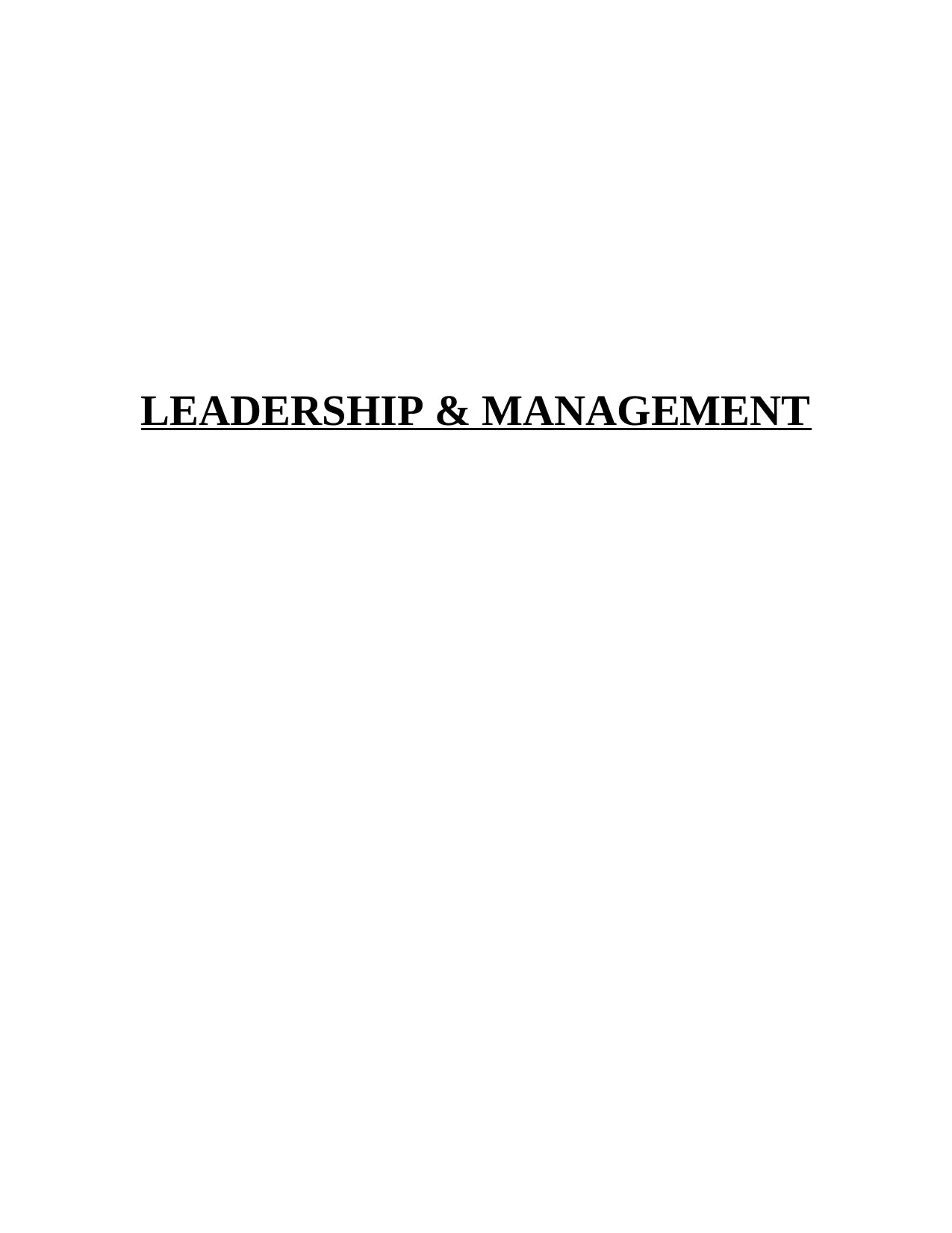
LEADERSHIP & MANAGEMENT
Paraphrase This Document
Need a fresh take? Get an instant paraphrase of this document with our AI Paraphraser
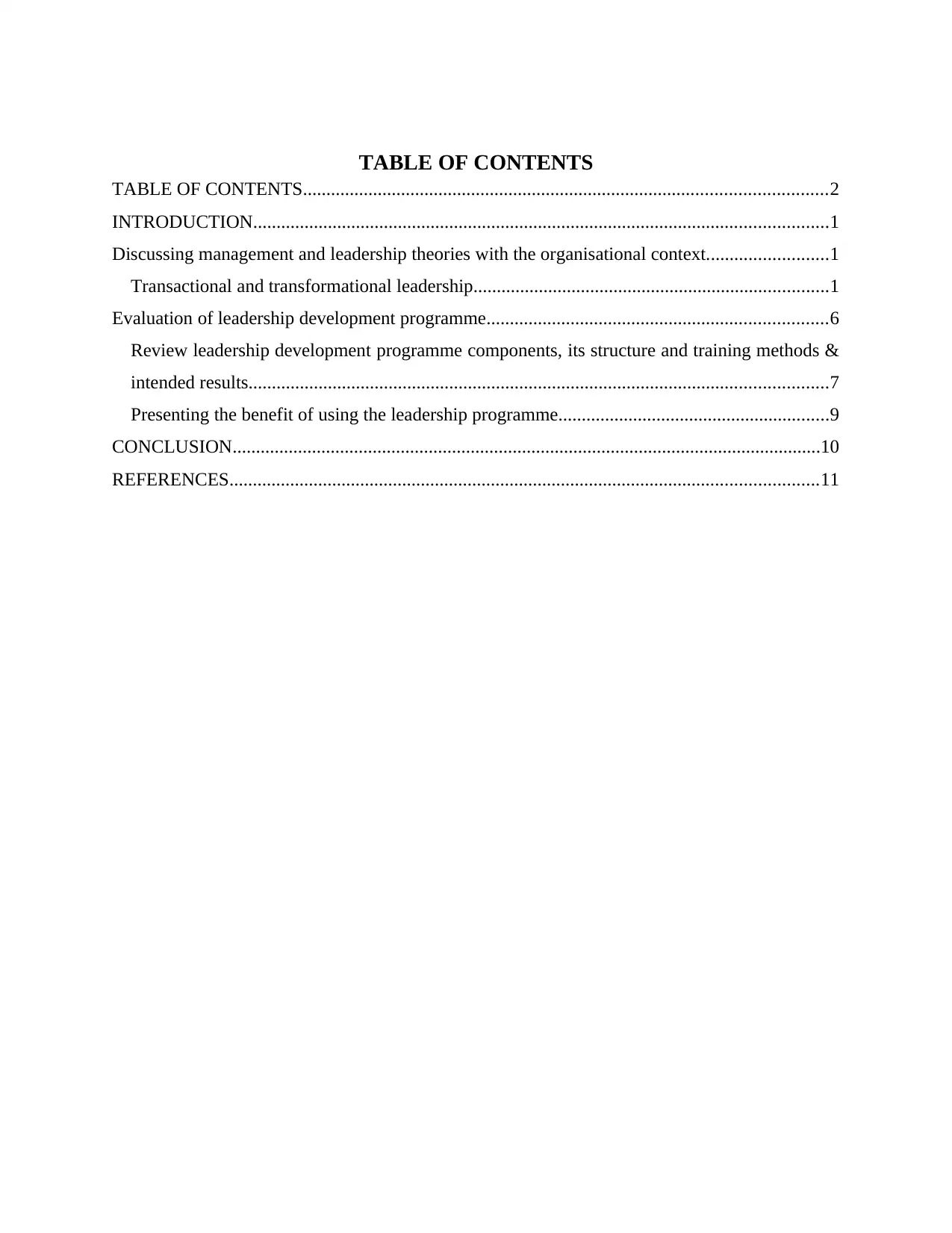
TABLE OF CONTENTS
TABLE OF CONTENTS................................................................................................................2
INTRODUCTION...........................................................................................................................1
Discussing management and leadership theories with the organisational context..........................1
Transactional and transformational leadership............................................................................1
Evaluation of leadership development programme.........................................................................6
Review leadership development programme components, its structure and training methods &
intended results............................................................................................................................7
Presenting the benefit of using the leadership programme..........................................................9
CONCLUSION..............................................................................................................................10
REFERENCES..............................................................................................................................11
TABLE OF CONTENTS................................................................................................................2
INTRODUCTION...........................................................................................................................1
Discussing management and leadership theories with the organisational context..........................1
Transactional and transformational leadership............................................................................1
Evaluation of leadership development programme.........................................................................6
Review leadership development programme components, its structure and training methods &
intended results............................................................................................................................7
Presenting the benefit of using the leadership programme..........................................................9
CONCLUSION..............................................................................................................................10
REFERENCES..............................................................................................................................11
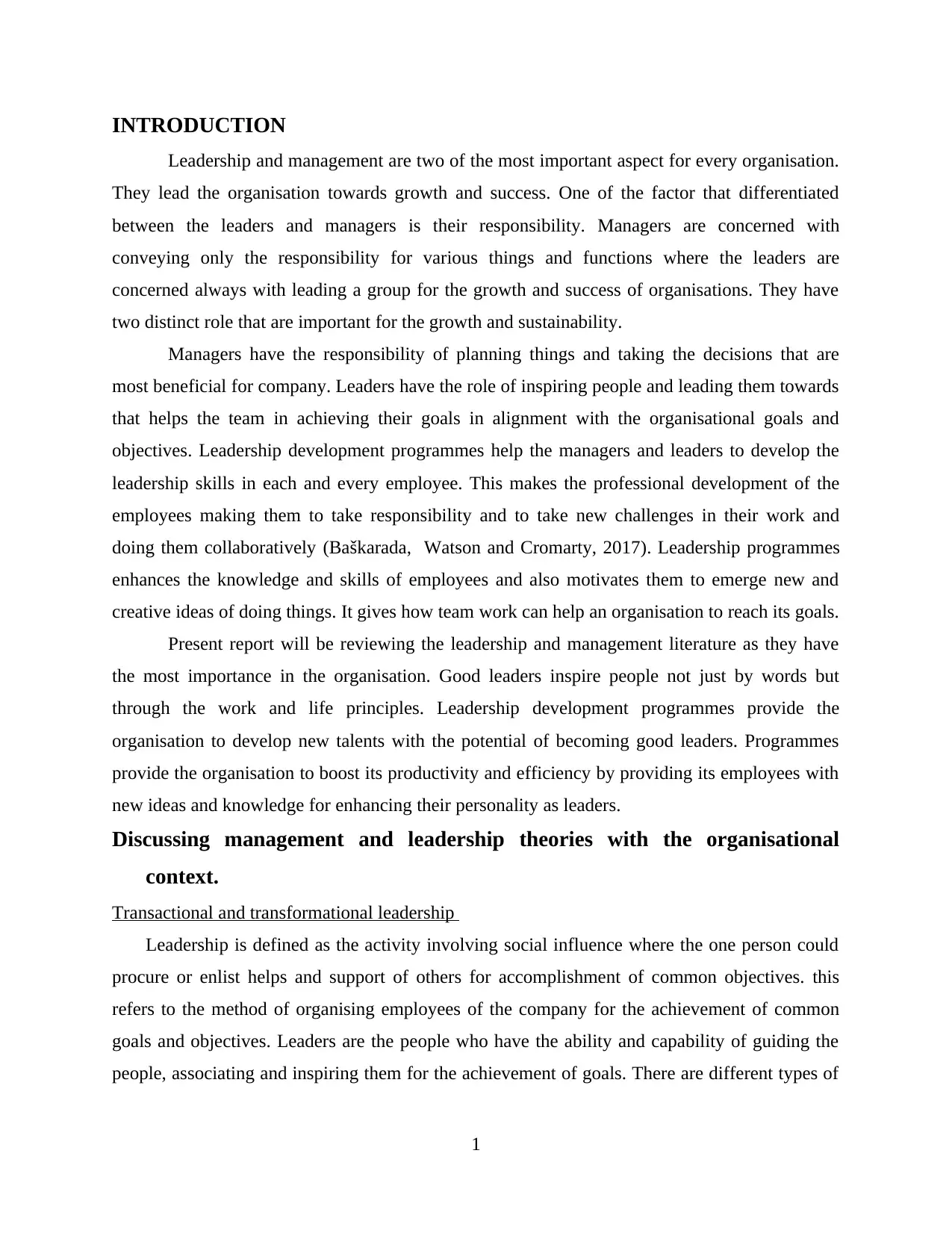
INTRODUCTION
Leadership and management are two of the most important aspect for every organisation.
They lead the organisation towards growth and success. One of the factor that differentiated
between the leaders and managers is their responsibility. Managers are concerned with
conveying only the responsibility for various things and functions where the leaders are
concerned always with leading a group for the growth and success of organisations. They have
two distinct role that are important for the growth and sustainability.
Managers have the responsibility of planning things and taking the decisions that are
most beneficial for company. Leaders have the role of inspiring people and leading them towards
that helps the team in achieving their goals in alignment with the organisational goals and
objectives. Leadership development programmes help the managers and leaders to develop the
leadership skills in each and every employee. This makes the professional development of the
employees making them to take responsibility and to take new challenges in their work and
doing them collaboratively (Baškarada, Watson and Cromarty, 2017). Leadership programmes
enhances the knowledge and skills of employees and also motivates them to emerge new and
creative ideas of doing things. It gives how team work can help an organisation to reach its goals.
Present report will be reviewing the leadership and management literature as they have
the most importance in the organisation. Good leaders inspire people not just by words but
through the work and life principles. Leadership development programmes provide the
organisation to develop new talents with the potential of becoming good leaders. Programmes
provide the organisation to boost its productivity and efficiency by providing its employees with
new ideas and knowledge for enhancing their personality as leaders.
Discussing management and leadership theories with the organisational
context.
Transactional and transformational leadership
Leadership is defined as the activity involving social influence where the one person could
procure or enlist helps and support of others for accomplishment of common objectives. this
refers to the method of organising employees of the company for the achievement of common
goals and objectives. Leaders are the people who have the ability and capability of guiding the
people, associating and inspiring them for the achievement of goals. There are different types of
1
Leadership and management are two of the most important aspect for every organisation.
They lead the organisation towards growth and success. One of the factor that differentiated
between the leaders and managers is their responsibility. Managers are concerned with
conveying only the responsibility for various things and functions where the leaders are
concerned always with leading a group for the growth and success of organisations. They have
two distinct role that are important for the growth and sustainability.
Managers have the responsibility of planning things and taking the decisions that are
most beneficial for company. Leaders have the role of inspiring people and leading them towards
that helps the team in achieving their goals in alignment with the organisational goals and
objectives. Leadership development programmes help the managers and leaders to develop the
leadership skills in each and every employee. This makes the professional development of the
employees making them to take responsibility and to take new challenges in their work and
doing them collaboratively (Baškarada, Watson and Cromarty, 2017). Leadership programmes
enhances the knowledge and skills of employees and also motivates them to emerge new and
creative ideas of doing things. It gives how team work can help an organisation to reach its goals.
Present report will be reviewing the leadership and management literature as they have
the most importance in the organisation. Good leaders inspire people not just by words but
through the work and life principles. Leadership development programmes provide the
organisation to develop new talents with the potential of becoming good leaders. Programmes
provide the organisation to boost its productivity and efficiency by providing its employees with
new ideas and knowledge for enhancing their personality as leaders.
Discussing management and leadership theories with the organisational
context.
Transactional and transformational leadership
Leadership is defined as the activity involving social influence where the one person could
procure or enlist helps and support of others for accomplishment of common objectives. this
refers to the method of organising employees of the company for the achievement of common
goals and objectives. Leaders are the people who have the ability and capability of guiding the
people, associating and inspiring them for the achievement of goals. There are different types of
1
⊘ This is a preview!⊘
Do you want full access?
Subscribe today to unlock all pages.

Trusted by 1+ million students worldwide
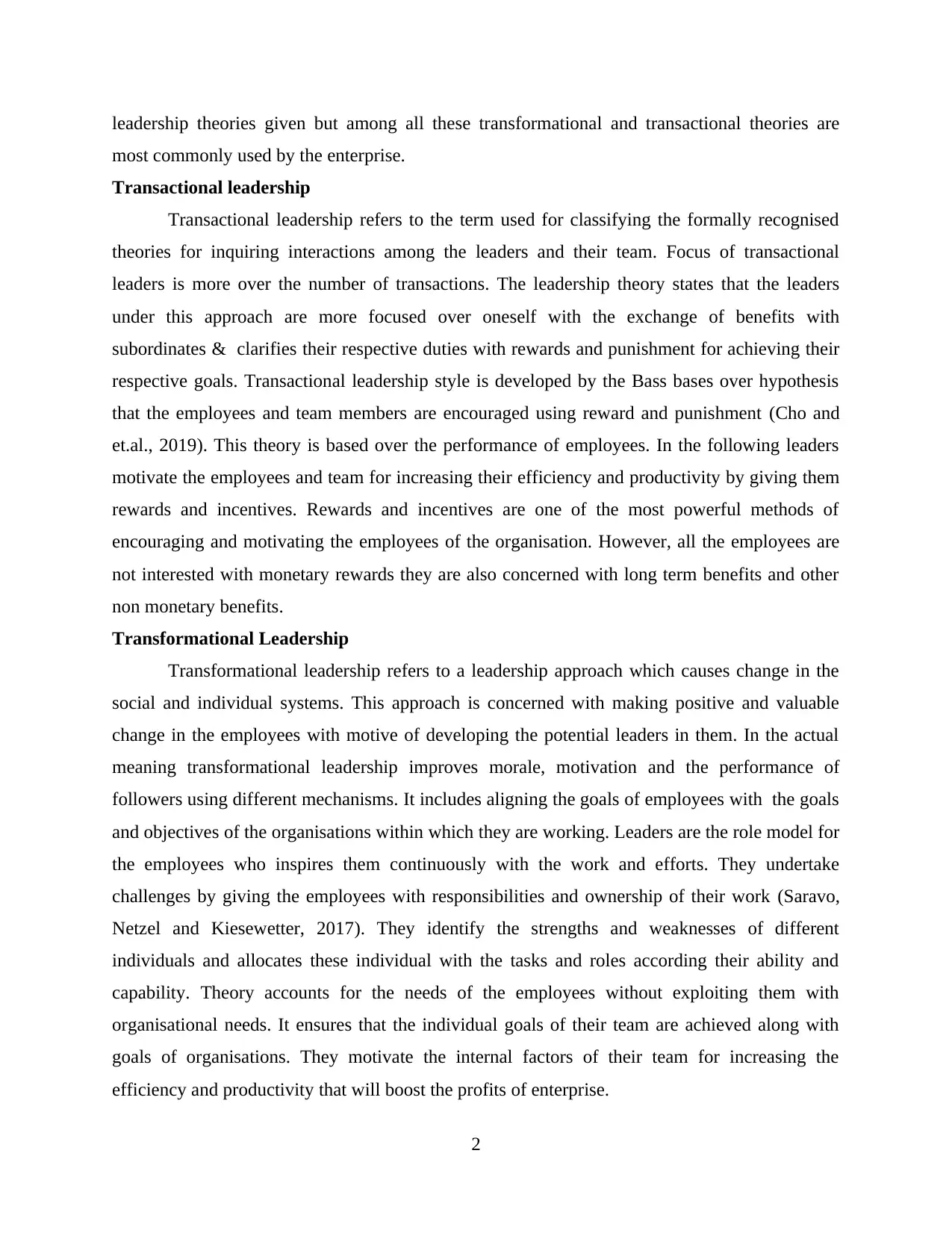
leadership theories given but among all these transformational and transactional theories are
most commonly used by the enterprise.
Transactional leadership
Transactional leadership refers to the term used for classifying the formally recognised
theories for inquiring interactions among the leaders and their team. Focus of transactional
leaders is more over the number of transactions. The leadership theory states that the leaders
under this approach are more focused over oneself with the exchange of benefits with
subordinates & clarifies their respective duties with rewards and punishment for achieving their
respective goals. Transactional leadership style is developed by the Bass bases over hypothesis
that the employees and team members are encouraged using reward and punishment (Cho and
et.al., 2019). This theory is based over the performance of employees. In the following leaders
motivate the employees and team for increasing their efficiency and productivity by giving them
rewards and incentives. Rewards and incentives are one of the most powerful methods of
encouraging and motivating the employees of the organisation. However, all the employees are
not interested with monetary rewards they are also concerned with long term benefits and other
non monetary benefits.
Transformational Leadership
Transformational leadership refers to a leadership approach which causes change in the
social and individual systems. This approach is concerned with making positive and valuable
change in the employees with motive of developing the potential leaders in them. In the actual
meaning transformational leadership improves morale, motivation and the performance of
followers using different mechanisms. It includes aligning the goals of employees with the goals
and objectives of the organisations within which they are working. Leaders are the role model for
the employees who inspires them continuously with the work and efforts. They undertake
challenges by giving the employees with responsibilities and ownership of their work (Saravo,
Netzel and Kiesewetter, 2017). They identify the strengths and weaknesses of different
individuals and allocates these individual with the tasks and roles according their ability and
capability. Theory accounts for the needs of the employees without exploiting them with
organisational needs. It ensures that the individual goals of their team are achieved along with
goals of organisations. They motivate the internal factors of their team for increasing the
efficiency and productivity that will boost the profits of enterprise.
2
most commonly used by the enterprise.
Transactional leadership
Transactional leadership refers to the term used for classifying the formally recognised
theories for inquiring interactions among the leaders and their team. Focus of transactional
leaders is more over the number of transactions. The leadership theory states that the leaders
under this approach are more focused over oneself with the exchange of benefits with
subordinates & clarifies their respective duties with rewards and punishment for achieving their
respective goals. Transactional leadership style is developed by the Bass bases over hypothesis
that the employees and team members are encouraged using reward and punishment (Cho and
et.al., 2019). This theory is based over the performance of employees. In the following leaders
motivate the employees and team for increasing their efficiency and productivity by giving them
rewards and incentives. Rewards and incentives are one of the most powerful methods of
encouraging and motivating the employees of the organisation. However, all the employees are
not interested with monetary rewards they are also concerned with long term benefits and other
non monetary benefits.
Transformational Leadership
Transformational leadership refers to a leadership approach which causes change in the
social and individual systems. This approach is concerned with making positive and valuable
change in the employees with motive of developing the potential leaders in them. In the actual
meaning transformational leadership improves morale, motivation and the performance of
followers using different mechanisms. It includes aligning the goals of employees with the goals
and objectives of the organisations within which they are working. Leaders are the role model for
the employees who inspires them continuously with the work and efforts. They undertake
challenges by giving the employees with responsibilities and ownership of their work (Saravo,
Netzel and Kiesewetter, 2017). They identify the strengths and weaknesses of different
individuals and allocates these individual with the tasks and roles according their ability and
capability. Theory accounts for the needs of the employees without exploiting them with
organisational needs. It ensures that the individual goals of their team are achieved along with
goals of organisations. They motivate the internal factors of their team for increasing the
efficiency and productivity that will boost the profits of enterprise.
2
Paraphrase This Document
Need a fresh take? Get an instant paraphrase of this document with our AI Paraphraser
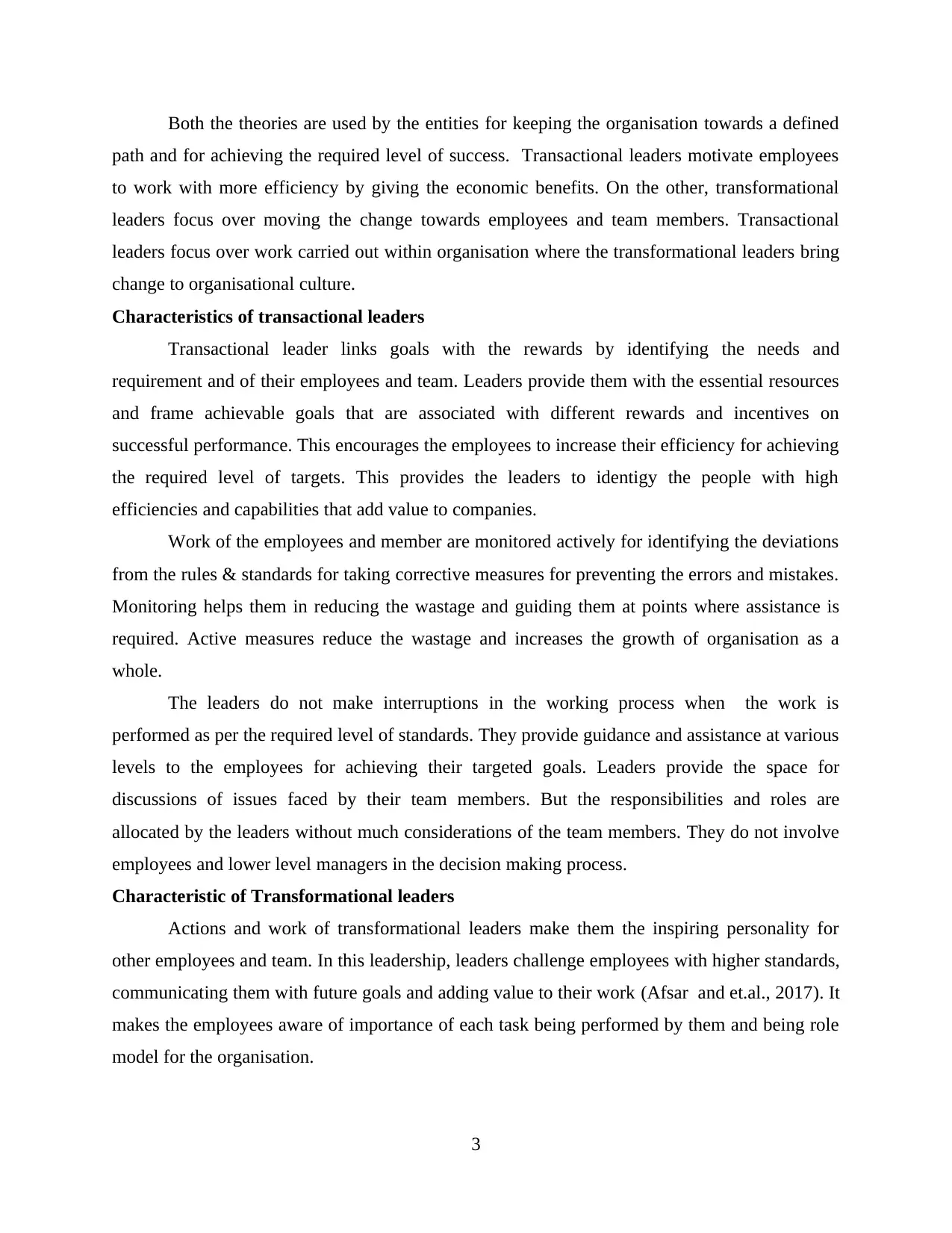
Both the theories are used by the entities for keeping the organisation towards a defined
path and for achieving the required level of success. Transactional leaders motivate employees
to work with more efficiency by giving the economic benefits. On the other, transformational
leaders focus over moving the change towards employees and team members. Transactional
leaders focus over work carried out within organisation where the transformational leaders bring
change to organisational culture.
Characteristics of transactional leaders
Transactional leader links goals with the rewards by identifying the needs and
requirement and of their employees and team. Leaders provide them with the essential resources
and frame achievable goals that are associated with different rewards and incentives on
successful performance. This encourages the employees to increase their efficiency for achieving
the required level of targets. This provides the leaders to identigy the people with high
efficiencies and capabilities that add value to companies.
Work of the employees and member are monitored actively for identifying the deviations
from the rules & standards for taking corrective measures for preventing the errors and mistakes.
Monitoring helps them in reducing the wastage and guiding them at points where assistance is
required. Active measures reduce the wastage and increases the growth of organisation as a
whole.
The leaders do not make interruptions in the working process when the work is
performed as per the required level of standards. They provide guidance and assistance at various
levels to the employees for achieving their targeted goals. Leaders provide the space for
discussions of issues faced by their team members. But the responsibilities and roles are
allocated by the leaders without much considerations of the team members. They do not involve
employees and lower level managers in the decision making process.
Characteristic of Transformational leaders
Actions and work of transformational leaders make them the inspiring personality for
other employees and team. In this leadership, leaders challenge employees with higher standards,
communicating them with future goals and adding value to their work (Afsar and et.al., 2017). It
makes the employees aware of importance of each task being performed by them and being role
model for the organisation.
3
path and for achieving the required level of success. Transactional leaders motivate employees
to work with more efficiency by giving the economic benefits. On the other, transformational
leaders focus over moving the change towards employees and team members. Transactional
leaders focus over work carried out within organisation where the transformational leaders bring
change to organisational culture.
Characteristics of transactional leaders
Transactional leader links goals with the rewards by identifying the needs and
requirement and of their employees and team. Leaders provide them with the essential resources
and frame achievable goals that are associated with different rewards and incentives on
successful performance. This encourages the employees to increase their efficiency for achieving
the required level of targets. This provides the leaders to identigy the people with high
efficiencies and capabilities that add value to companies.
Work of the employees and member are monitored actively for identifying the deviations
from the rules & standards for taking corrective measures for preventing the errors and mistakes.
Monitoring helps them in reducing the wastage and guiding them at points where assistance is
required. Active measures reduce the wastage and increases the growth of organisation as a
whole.
The leaders do not make interruptions in the working process when the work is
performed as per the required level of standards. They provide guidance and assistance at various
levels to the employees for achieving their targeted goals. Leaders provide the space for
discussions of issues faced by their team members. But the responsibilities and roles are
allocated by the leaders without much considerations of the team members. They do not involve
employees and lower level managers in the decision making process.
Characteristic of Transformational leaders
Actions and work of transformational leaders make them the inspiring personality for
other employees and team. In this leadership, leaders challenge employees with higher standards,
communicating them with future goals and adding value to their work (Afsar and et.al., 2017). It
makes the employees aware of importance of each task being performed by them and being role
model for the organisation.
3
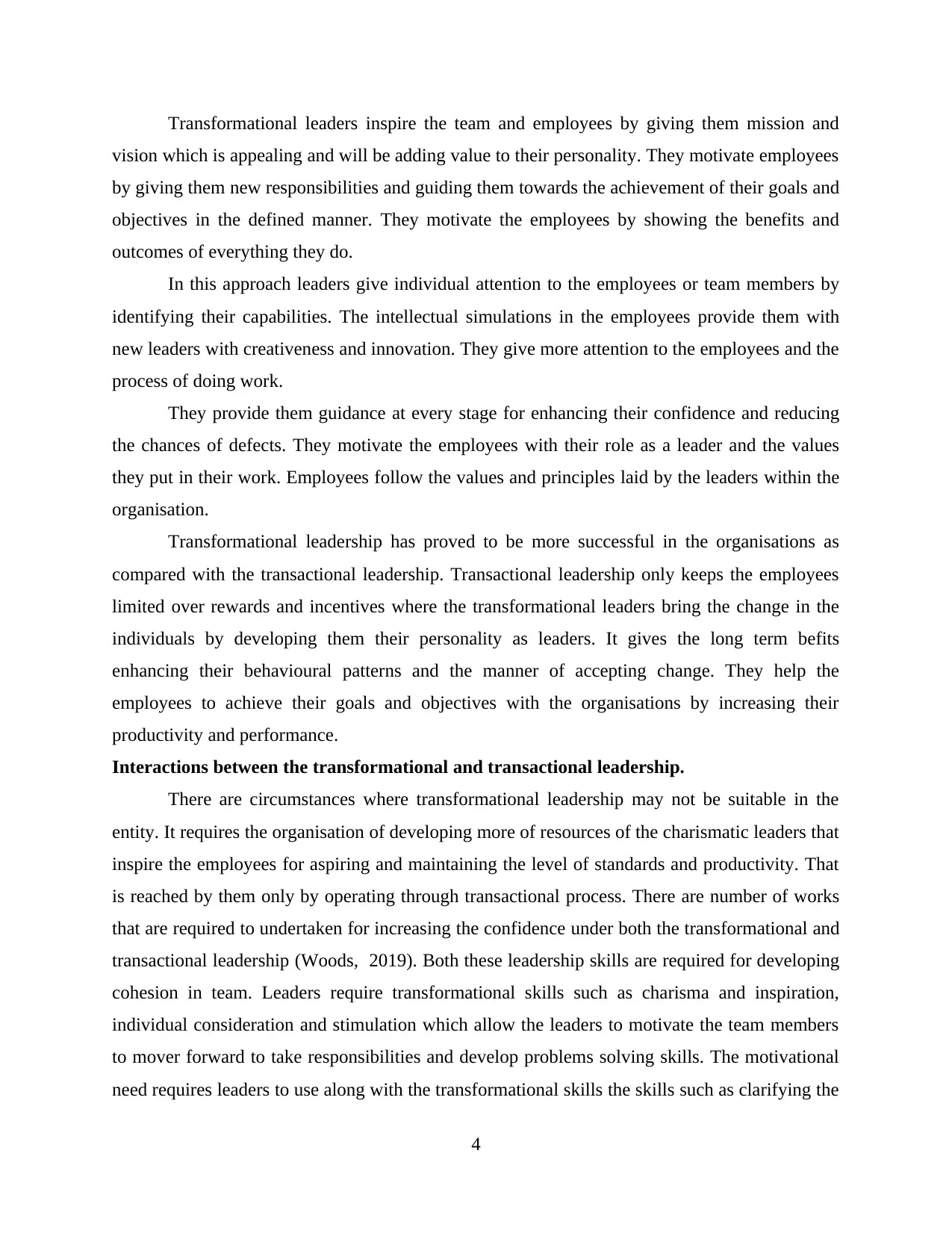
Transformational leaders inspire the team and employees by giving them mission and
vision which is appealing and will be adding value to their personality. They motivate employees
by giving them new responsibilities and guiding them towards the achievement of their goals and
objectives in the defined manner. They motivate the employees by showing the benefits and
outcomes of everything they do.
In this approach leaders give individual attention to the employees or team members by
identifying their capabilities. The intellectual simulations in the employees provide them with
new leaders with creativeness and innovation. They give more attention to the employees and the
process of doing work.
They provide them guidance at every stage for enhancing their confidence and reducing
the chances of defects. They motivate the employees with their role as a leader and the values
they put in their work. Employees follow the values and principles laid by the leaders within the
organisation.
Transformational leadership has proved to be more successful in the organisations as
compared with the transactional leadership. Transactional leadership only keeps the employees
limited over rewards and incentives where the transformational leaders bring the change in the
individuals by developing them their personality as leaders. It gives the long term befits
enhancing their behavioural patterns and the manner of accepting change. They help the
employees to achieve their goals and objectives with the organisations by increasing their
productivity and performance.
Interactions between the transformational and transactional leadership.
There are circumstances where transformational leadership may not be suitable in the
entity. It requires the organisation of developing more of resources of the charismatic leaders that
inspire the employees for aspiring and maintaining the level of standards and productivity. That
is reached by them only by operating through transactional process. There are number of works
that are required to undertaken for increasing the confidence under both the transformational and
transactional leadership (Woods, 2019). Both these leadership skills are required for developing
cohesion in team. Leaders require transformational skills such as charisma and inspiration,
individual consideration and stimulation which allow the leaders to motivate the team members
to mover forward to take responsibilities and develop problems solving skills. The motivational
need requires leaders to use along with the transformational skills the skills such as clarifying the
4
vision which is appealing and will be adding value to their personality. They motivate employees
by giving them new responsibilities and guiding them towards the achievement of their goals and
objectives in the defined manner. They motivate the employees by showing the benefits and
outcomes of everything they do.
In this approach leaders give individual attention to the employees or team members by
identifying their capabilities. The intellectual simulations in the employees provide them with
new leaders with creativeness and innovation. They give more attention to the employees and the
process of doing work.
They provide them guidance at every stage for enhancing their confidence and reducing
the chances of defects. They motivate the employees with their role as a leader and the values
they put in their work. Employees follow the values and principles laid by the leaders within the
organisation.
Transformational leadership has proved to be more successful in the organisations as
compared with the transactional leadership. Transactional leadership only keeps the employees
limited over rewards and incentives where the transformational leaders bring the change in the
individuals by developing them their personality as leaders. It gives the long term befits
enhancing their behavioural patterns and the manner of accepting change. They help the
employees to achieve their goals and objectives with the organisations by increasing their
productivity and performance.
Interactions between the transformational and transactional leadership.
There are circumstances where transformational leadership may not be suitable in the
entity. It requires the organisation of developing more of resources of the charismatic leaders that
inspire the employees for aspiring and maintaining the level of standards and productivity. That
is reached by them only by operating through transactional process. There are number of works
that are required to undertaken for increasing the confidence under both the transformational and
transactional leadership (Woods, 2019). Both these leadership skills are required for developing
cohesion in team. Leaders require transformational skills such as charisma and inspiration,
individual consideration and stimulation which allow the leaders to motivate the team members
to mover forward to take responsibilities and develop problems solving skills. The motivational
need requires leaders to use along with the transformational skills the skills such as clarifying the
4
⊘ This is a preview!⊘
Do you want full access?
Subscribe today to unlock all pages.

Trusted by 1+ million students worldwide
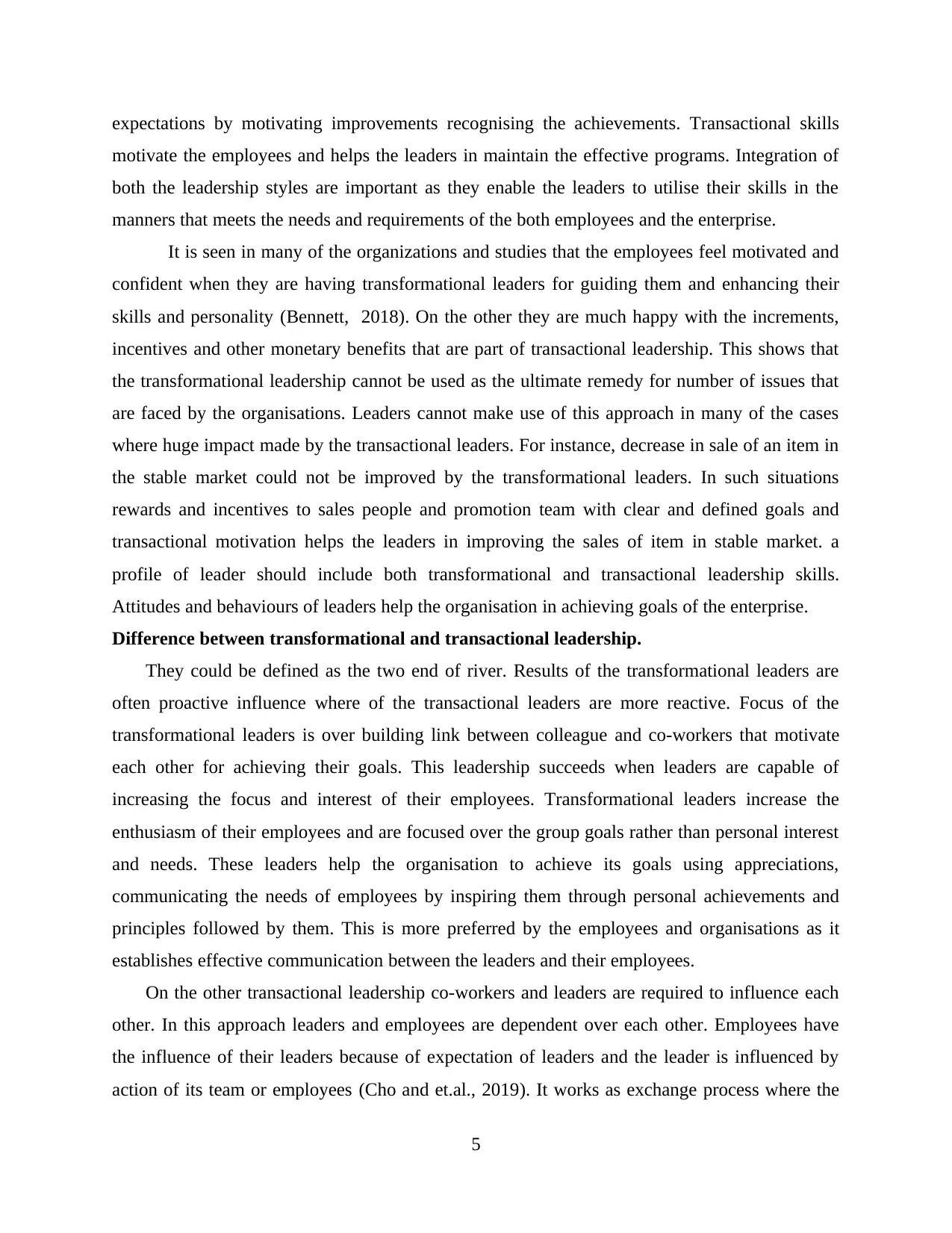
expectations by motivating improvements recognising the achievements. Transactional skills
motivate the employees and helps the leaders in maintain the effective programs. Integration of
both the leadership styles are important as they enable the leaders to utilise their skills in the
manners that meets the needs and requirements of the both employees and the enterprise.
It is seen in many of the organizations and studies that the employees feel motivated and
confident when they are having transformational leaders for guiding them and enhancing their
skills and personality (Bennett, 2018). On the other they are much happy with the increments,
incentives and other monetary benefits that are part of transactional leadership. This shows that
the transformational leadership cannot be used as the ultimate remedy for number of issues that
are faced by the organisations. Leaders cannot make use of this approach in many of the cases
where huge impact made by the transactional leaders. For instance, decrease in sale of an item in
the stable market could not be improved by the transformational leaders. In such situations
rewards and incentives to sales people and promotion team with clear and defined goals and
transactional motivation helps the leaders in improving the sales of item in stable market. a
profile of leader should include both transformational and transactional leadership skills.
Attitudes and behaviours of leaders help the organisation in achieving goals of the enterprise.
Difference between transformational and transactional leadership.
They could be defined as the two end of river. Results of the transformational leaders are
often proactive influence where of the transactional leaders are more reactive. Focus of the
transformational leaders is over building link between colleague and co-workers that motivate
each other for achieving their goals. This leadership succeeds when leaders are capable of
increasing the focus and interest of their employees. Transformational leaders increase the
enthusiasm of their employees and are focused over the group goals rather than personal interest
and needs. These leaders help the organisation to achieve its goals using appreciations,
communicating the needs of employees by inspiring them through personal achievements and
principles followed by them. This is more preferred by the employees and organisations as it
establishes effective communication between the leaders and their employees.
On the other transactional leadership co-workers and leaders are required to influence each
other. In this approach leaders and employees are dependent over each other. Employees have
the influence of their leaders because of expectation of leaders and the leader is influenced by
action of its team or employees (Cho and et.al., 2019). It works as exchange process where the
5
motivate the employees and helps the leaders in maintain the effective programs. Integration of
both the leadership styles are important as they enable the leaders to utilise their skills in the
manners that meets the needs and requirements of the both employees and the enterprise.
It is seen in many of the organizations and studies that the employees feel motivated and
confident when they are having transformational leaders for guiding them and enhancing their
skills and personality (Bennett, 2018). On the other they are much happy with the increments,
incentives and other monetary benefits that are part of transactional leadership. This shows that
the transformational leadership cannot be used as the ultimate remedy for number of issues that
are faced by the organisations. Leaders cannot make use of this approach in many of the cases
where huge impact made by the transactional leaders. For instance, decrease in sale of an item in
the stable market could not be improved by the transformational leaders. In such situations
rewards and incentives to sales people and promotion team with clear and defined goals and
transactional motivation helps the leaders in improving the sales of item in stable market. a
profile of leader should include both transformational and transactional leadership skills.
Attitudes and behaviours of leaders help the organisation in achieving goals of the enterprise.
Difference between transformational and transactional leadership.
They could be defined as the two end of river. Results of the transformational leaders are
often proactive influence where of the transactional leaders are more reactive. Focus of the
transformational leaders is over building link between colleague and co-workers that motivate
each other for achieving their goals. This leadership succeeds when leaders are capable of
increasing the focus and interest of their employees. Transformational leaders increase the
enthusiasm of their employees and are focused over the group goals rather than personal interest
and needs. These leaders help the organisation to achieve its goals using appreciations,
communicating the needs of employees by inspiring them through personal achievements and
principles followed by them. This is more preferred by the employees and organisations as it
establishes effective communication between the leaders and their employees.
On the other transactional leadership co-workers and leaders are required to influence each
other. In this approach leaders and employees are dependent over each other. Employees have
the influence of their leaders because of expectation of leaders and the leader is influenced by
action of its team or employees (Cho and et.al., 2019). It works as exchange process where the
5
Paraphrase This Document
Need a fresh take? Get an instant paraphrase of this document with our AI Paraphraser
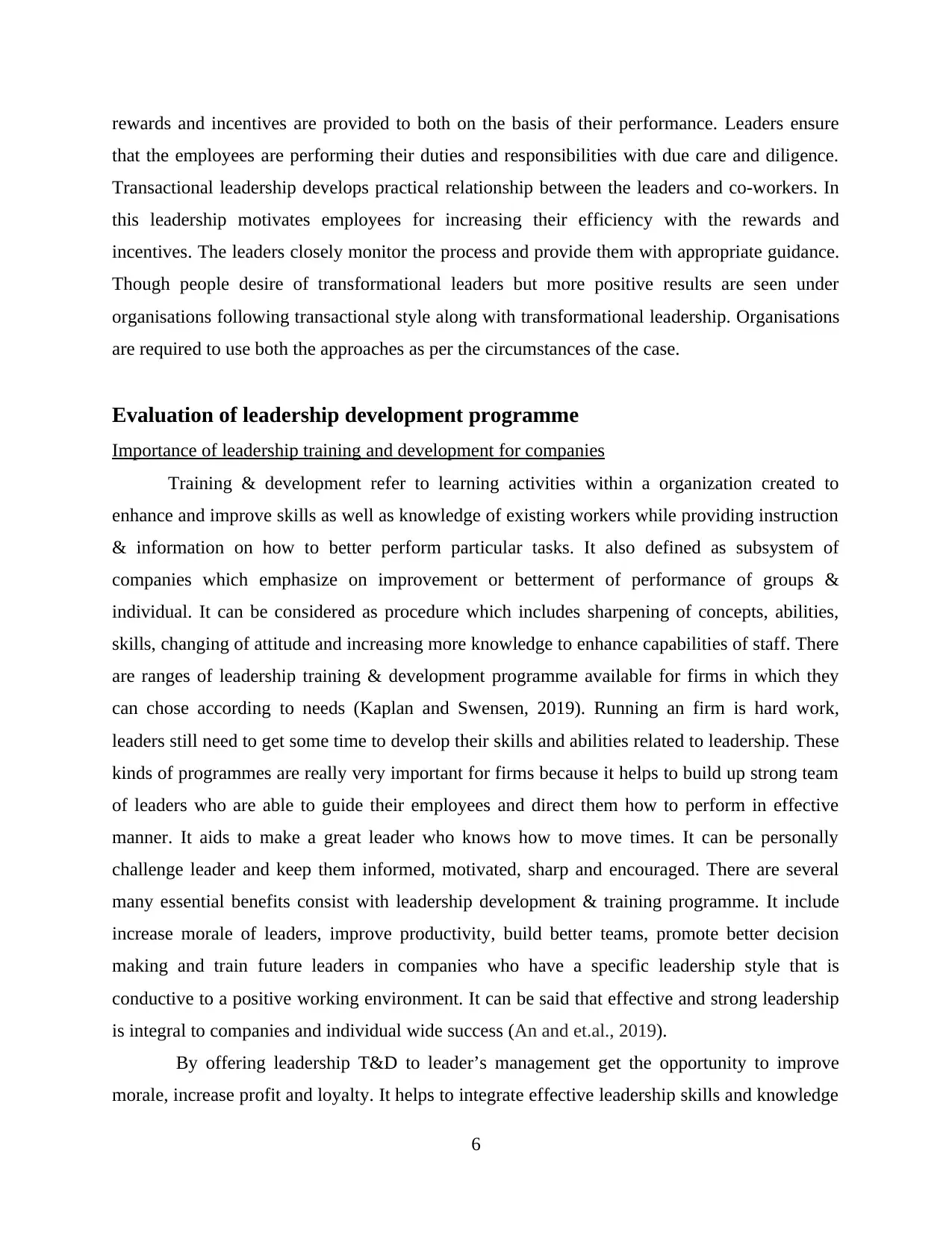
rewards and incentives are provided to both on the basis of their performance. Leaders ensure
that the employees are performing their duties and responsibilities with due care and diligence.
Transactional leadership develops practical relationship between the leaders and co-workers. In
this leadership motivates employees for increasing their efficiency with the rewards and
incentives. The leaders closely monitor the process and provide them with appropriate guidance.
Though people desire of transformational leaders but more positive results are seen under
organisations following transactional style along with transformational leadership. Organisations
are required to use both the approaches as per the circumstances of the case.
Evaluation of leadership development programme
Importance of leadership training and development for companies
Training & development refer to learning activities within a organization created to
enhance and improve skills as well as knowledge of existing workers while providing instruction
& information on how to better perform particular tasks. It also defined as subsystem of
companies which emphasize on improvement or betterment of performance of groups &
individual. It can be considered as procedure which includes sharpening of concepts, abilities,
skills, changing of attitude and increasing more knowledge to enhance capabilities of staff. There
are ranges of leadership training & development programme available for firms in which they
can chose according to needs (Kaplan and Swensen, 2019). Running an firm is hard work,
leaders still need to get some time to develop their skills and abilities related to leadership. These
kinds of programmes are really very important for firms because it helps to build up strong team
of leaders who are able to guide their employees and direct them how to perform in effective
manner. It aids to make a great leader who knows how to move times. It can be personally
challenge leader and keep them informed, motivated, sharp and encouraged. There are several
many essential benefits consist with leadership development & training programme. It include
increase morale of leaders, improve productivity, build better teams, promote better decision
making and train future leaders in companies who have a specific leadership style that is
conductive to a positive working environment. It can be said that effective and strong leadership
is integral to companies and individual wide success (An and et.al., 2019).
By offering leadership T&D to leader’s management get the opportunity to improve
morale, increase profit and loyalty. It helps to integrate effective leadership skills and knowledge
6
that the employees are performing their duties and responsibilities with due care and diligence.
Transactional leadership develops practical relationship between the leaders and co-workers. In
this leadership motivates employees for increasing their efficiency with the rewards and
incentives. The leaders closely monitor the process and provide them with appropriate guidance.
Though people desire of transformational leaders but more positive results are seen under
organisations following transactional style along with transformational leadership. Organisations
are required to use both the approaches as per the circumstances of the case.
Evaluation of leadership development programme
Importance of leadership training and development for companies
Training & development refer to learning activities within a organization created to
enhance and improve skills as well as knowledge of existing workers while providing instruction
& information on how to better perform particular tasks. It also defined as subsystem of
companies which emphasize on improvement or betterment of performance of groups &
individual. It can be considered as procedure which includes sharpening of concepts, abilities,
skills, changing of attitude and increasing more knowledge to enhance capabilities of staff. There
are ranges of leadership training & development programme available for firms in which they
can chose according to needs (Kaplan and Swensen, 2019). Running an firm is hard work,
leaders still need to get some time to develop their skills and abilities related to leadership. These
kinds of programmes are really very important for firms because it helps to build up strong team
of leaders who are able to guide their employees and direct them how to perform in effective
manner. It aids to make a great leader who knows how to move times. It can be personally
challenge leader and keep them informed, motivated, sharp and encouraged. There are several
many essential benefits consist with leadership development & training programme. It include
increase morale of leaders, improve productivity, build better teams, promote better decision
making and train future leaders in companies who have a specific leadership style that is
conductive to a positive working environment. It can be said that effective and strong leadership
is integral to companies and individual wide success (An and et.al., 2019).
By offering leadership T&D to leader’s management get the opportunity to improve
morale, increase profit and loyalty. It helps to integrate effective leadership skills and knowledge
6
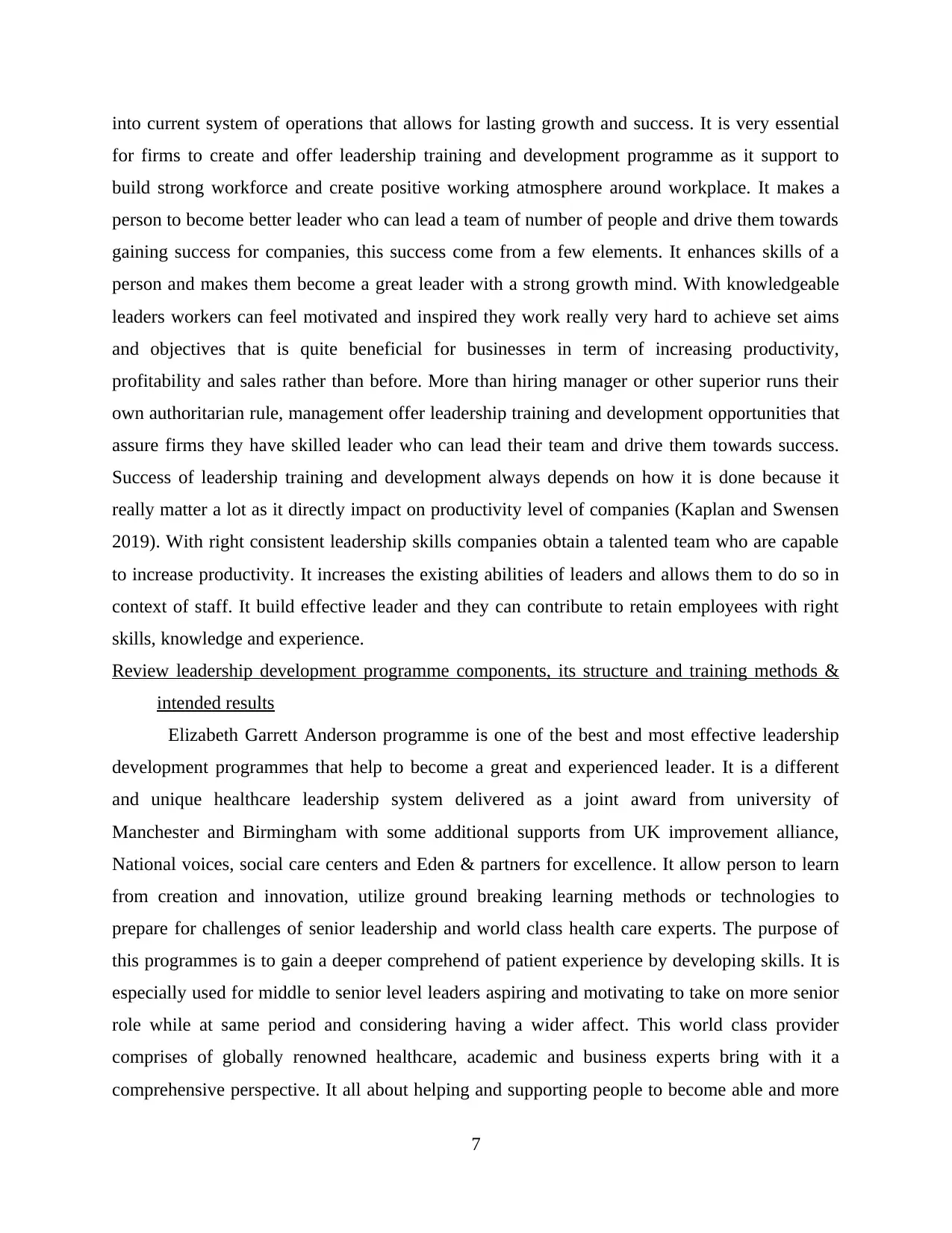
into current system of operations that allows for lasting growth and success. It is very essential
for firms to create and offer leadership training and development programme as it support to
build strong workforce and create positive working atmosphere around workplace. It makes a
person to become better leader who can lead a team of number of people and drive them towards
gaining success for companies, this success come from a few elements. It enhances skills of a
person and makes them become a great leader with a strong growth mind. With knowledgeable
leaders workers can feel motivated and inspired they work really very hard to achieve set aims
and objectives that is quite beneficial for businesses in term of increasing productivity,
profitability and sales rather than before. More than hiring manager or other superior runs their
own authoritarian rule, management offer leadership training and development opportunities that
assure firms they have skilled leader who can lead their team and drive them towards success.
Success of leadership training and development always depends on how it is done because it
really matter a lot as it directly impact on productivity level of companies (Kaplan and Swensen
2019). With right consistent leadership skills companies obtain a talented team who are capable
to increase productivity. It increases the existing abilities of leaders and allows them to do so in
context of staff. It build effective leader and they can contribute to retain employees with right
skills, knowledge and experience.
Review leadership development programme components, its structure and training methods &
intended results
Elizabeth Garrett Anderson programme is one of the best and most effective leadership
development programmes that help to become a great and experienced leader. It is a different
and unique healthcare leadership system delivered as a joint award from university of
Manchester and Birmingham with some additional supports from UK improvement alliance,
National voices, social care centers and Eden & partners for excellence. It allow person to learn
from creation and innovation, utilize ground breaking learning methods or technologies to
prepare for challenges of senior leadership and world class health care experts. The purpose of
this programmes is to gain a deeper comprehend of patient experience by developing skills. It is
especially used for middle to senior level leaders aspiring and motivating to take on more senior
role while at same period and considering having a wider affect. This world class provider
comprises of globally renowned healthcare, academic and business experts bring with it a
comprehensive perspective. It all about helping and supporting people to become able and more
7
for firms to create and offer leadership training and development programme as it support to
build strong workforce and create positive working atmosphere around workplace. It makes a
person to become better leader who can lead a team of number of people and drive them towards
gaining success for companies, this success come from a few elements. It enhances skills of a
person and makes them become a great leader with a strong growth mind. With knowledgeable
leaders workers can feel motivated and inspired they work really very hard to achieve set aims
and objectives that is quite beneficial for businesses in term of increasing productivity,
profitability and sales rather than before. More than hiring manager or other superior runs their
own authoritarian rule, management offer leadership training and development opportunities that
assure firms they have skilled leader who can lead their team and drive them towards success.
Success of leadership training and development always depends on how it is done because it
really matter a lot as it directly impact on productivity level of companies (Kaplan and Swensen
2019). With right consistent leadership skills companies obtain a talented team who are capable
to increase productivity. It increases the existing abilities of leaders and allows them to do so in
context of staff. It build effective leader and they can contribute to retain employees with right
skills, knowledge and experience.
Review leadership development programme components, its structure and training methods &
intended results
Elizabeth Garrett Anderson programme is one of the best and most effective leadership
development programmes that help to become a great and experienced leader. It is a different
and unique healthcare leadership system delivered as a joint award from university of
Manchester and Birmingham with some additional supports from UK improvement alliance,
National voices, social care centers and Eden & partners for excellence. It allow person to learn
from creation and innovation, utilize ground breaking learning methods or technologies to
prepare for challenges of senior leadership and world class health care experts. The purpose of
this programmes is to gain a deeper comprehend of patient experience by developing skills. It is
especially used for middle to senior level leaders aspiring and motivating to take on more senior
role while at same period and considering having a wider affect. This world class provider
comprises of globally renowned healthcare, academic and business experts bring with it a
comprehensive perspective. It all about helping and supporting people to become able and more
7
⊘ This is a preview!⊘
Do you want full access?
Subscribe today to unlock all pages.

Trusted by 1+ million students worldwide
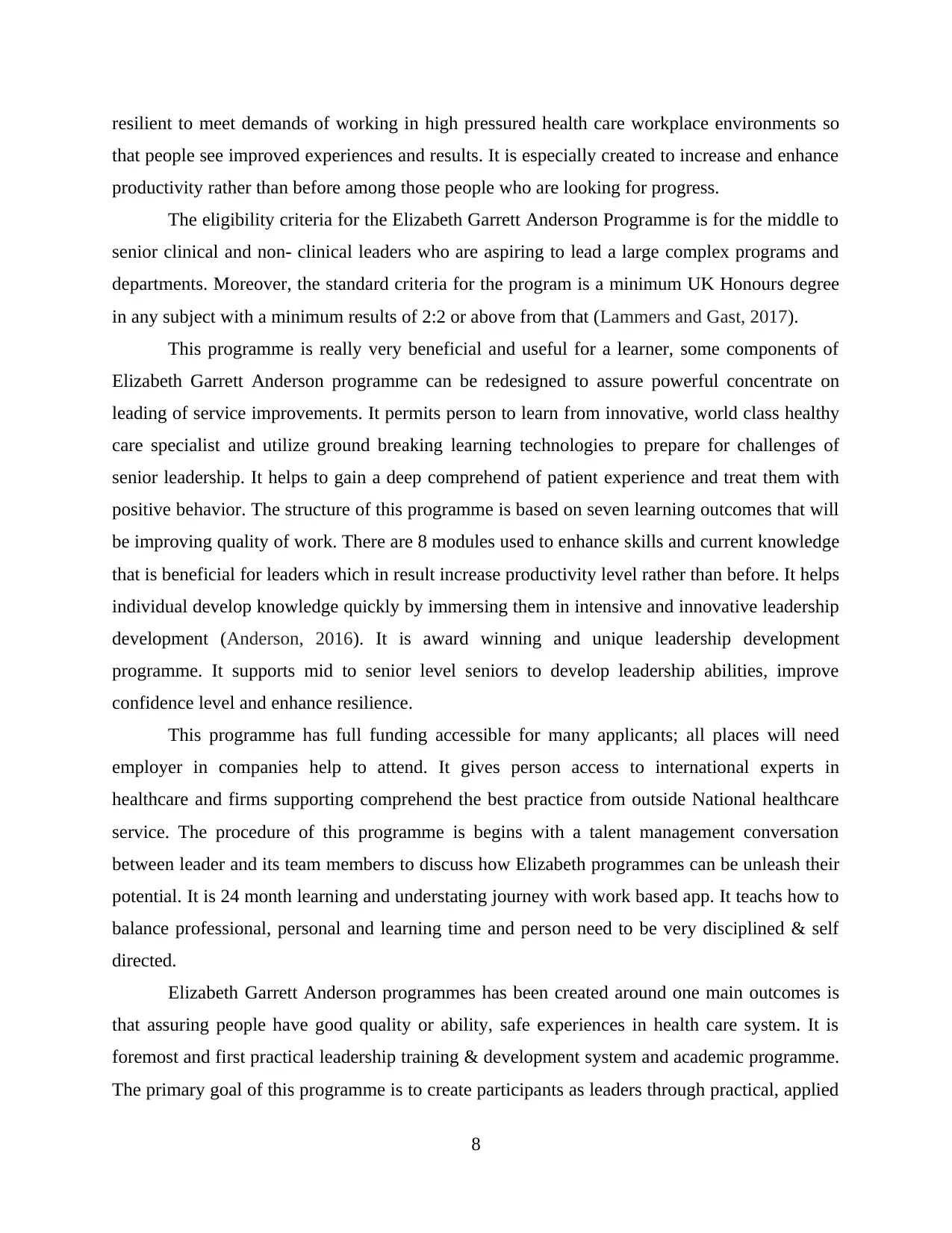
resilient to meet demands of working in high pressured health care workplace environments so
that people see improved experiences and results. It is especially created to increase and enhance
productivity rather than before among those people who are looking for progress.
The eligibility criteria for the Elizabeth Garrett Anderson Programme is for the middle to
senior clinical and non- clinical leaders who are aspiring to lead a large complex programs and
departments. Moreover, the standard criteria for the program is a minimum UK Honours degree
in any subject with a minimum results of 2:2 or above from that (Lammers and Gast, 2017).
This programme is really very beneficial and useful for a learner, some components of
Elizabeth Garrett Anderson programme can be redesigned to assure powerful concentrate on
leading of service improvements. It permits person to learn from innovative, world class healthy
care specialist and utilize ground breaking learning technologies to prepare for challenges of
senior leadership. It helps to gain a deep comprehend of patient experience and treat them with
positive behavior. The structure of this programme is based on seven learning outcomes that will
be improving quality of work. There are 8 modules used to enhance skills and current knowledge
that is beneficial for leaders which in result increase productivity level rather than before. It helps
individual develop knowledge quickly by immersing them in intensive and innovative leadership
development (Anderson, 2016). It is award winning and unique leadership development
programme. It supports mid to senior level seniors to develop leadership abilities, improve
confidence level and enhance resilience.
This programme has full funding accessible for many applicants; all places will need
employer in companies help to attend. It gives person access to international experts in
healthcare and firms supporting comprehend the best practice from outside National healthcare
service. The procedure of this programme is begins with a talent management conversation
between leader and its team members to discuss how Elizabeth programmes can be unleash their
potential. It is 24 month learning and understating journey with work based app. It teachs how to
balance professional, personal and learning time and person need to be very disciplined & self
directed.
Elizabeth Garrett Anderson programmes has been created around one main outcomes is
that assuring people have good quality or ability, safe experiences in health care system. It is
foremost and first practical leadership training & development system and academic programme.
The primary goal of this programme is to create participants as leaders through practical, applied
8
that people see improved experiences and results. It is especially created to increase and enhance
productivity rather than before among those people who are looking for progress.
The eligibility criteria for the Elizabeth Garrett Anderson Programme is for the middle to
senior clinical and non- clinical leaders who are aspiring to lead a large complex programs and
departments. Moreover, the standard criteria for the program is a minimum UK Honours degree
in any subject with a minimum results of 2:2 or above from that (Lammers and Gast, 2017).
This programme is really very beneficial and useful for a learner, some components of
Elizabeth Garrett Anderson programme can be redesigned to assure powerful concentrate on
leading of service improvements. It permits person to learn from innovative, world class healthy
care specialist and utilize ground breaking learning technologies to prepare for challenges of
senior leadership. It helps to gain a deep comprehend of patient experience and treat them with
positive behavior. The structure of this programme is based on seven learning outcomes that will
be improving quality of work. There are 8 modules used to enhance skills and current knowledge
that is beneficial for leaders which in result increase productivity level rather than before. It helps
individual develop knowledge quickly by immersing them in intensive and innovative leadership
development (Anderson, 2016). It is award winning and unique leadership development
programme. It supports mid to senior level seniors to develop leadership abilities, improve
confidence level and enhance resilience.
This programme has full funding accessible for many applicants; all places will need
employer in companies help to attend. It gives person access to international experts in
healthcare and firms supporting comprehend the best practice from outside National healthcare
service. The procedure of this programme is begins with a talent management conversation
between leader and its team members to discuss how Elizabeth programmes can be unleash their
potential. It is 24 month learning and understating journey with work based app. It teachs how to
balance professional, personal and learning time and person need to be very disciplined & self
directed.
Elizabeth Garrett Anderson programmes has been created around one main outcomes is
that assuring people have good quality or ability, safe experiences in health care system. It is
foremost and first practical leadership training & development system and academic programme.
The primary goal of this programme is to create participants as leaders through practical, applied
8
Paraphrase This Document
Need a fresh take? Get an instant paraphrase of this document with our AI Paraphraser
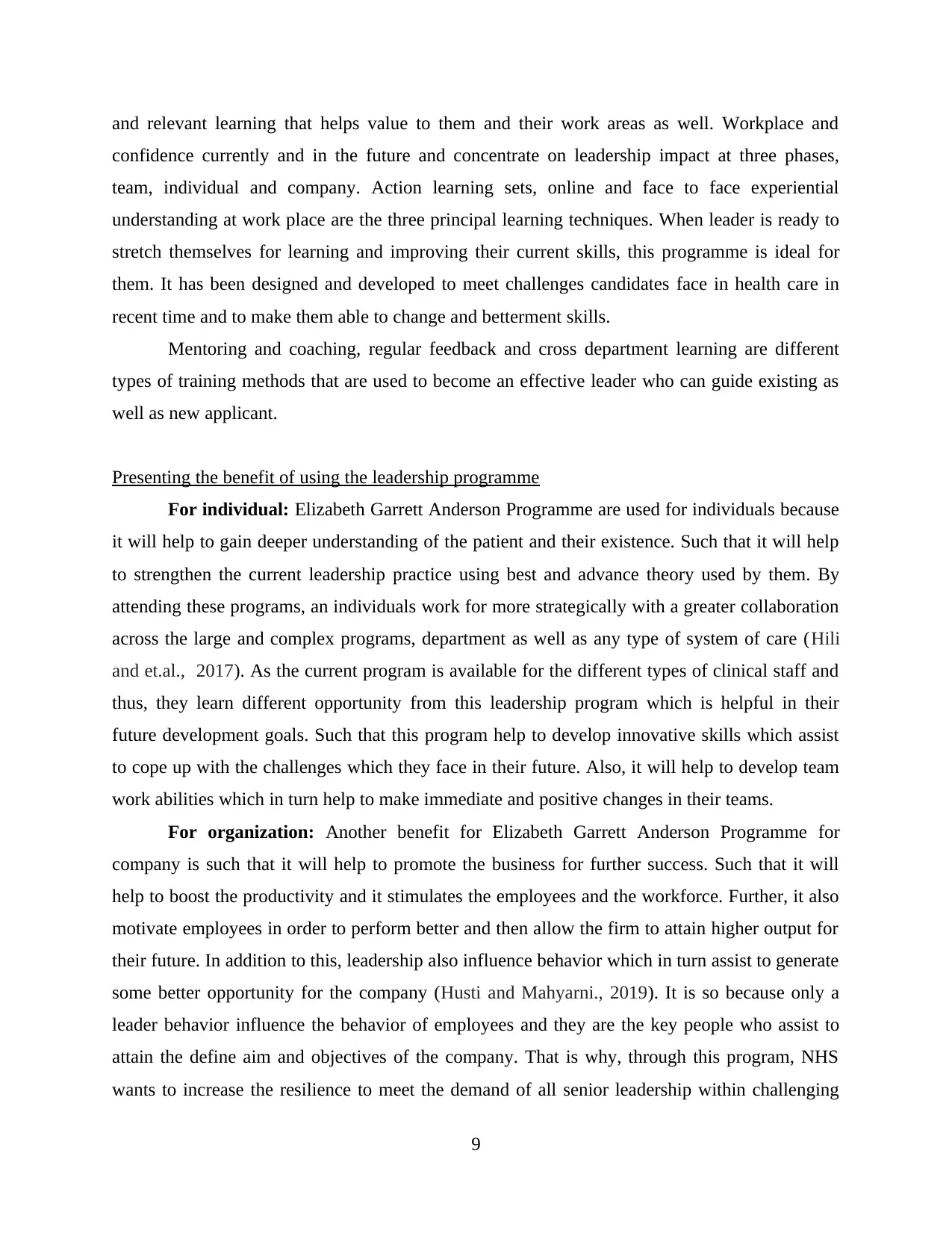
and relevant learning that helps value to them and their work areas as well. Workplace and
confidence currently and in the future and concentrate on leadership impact at three phases,
team, individual and company. Action learning sets, online and face to face experiential
understanding at work place are the three principal learning techniques. When leader is ready to
stretch themselves for learning and improving their current skills, this programme is ideal for
them. It has been designed and developed to meet challenges candidates face in health care in
recent time and to make them able to change and betterment skills.
Mentoring and coaching, regular feedback and cross department learning are different
types of training methods that are used to become an effective leader who can guide existing as
well as new applicant.
Presenting the benefit of using the leadership programme
For individual: Elizabeth Garrett Anderson Programme are used for individuals because
it will help to gain deeper understanding of the patient and their existence. Such that it will help
to strengthen the current leadership practice using best and advance theory used by them. By
attending these programs, an individuals work for more strategically with a greater collaboration
across the large and complex programs, department as well as any type of system of care (Hili
and et.al., 2017). As the current program is available for the different types of clinical staff and
thus, they learn different opportunity from this leadership program which is helpful in their
future development goals. Such that this program help to develop innovative skills which assist
to cope up with the challenges which they face in their future. Also, it will help to develop team
work abilities which in turn help to make immediate and positive changes in their teams.
For organization: Another benefit for Elizabeth Garrett Anderson Programme for
company is such that it will help to promote the business for further success. Such that it will
help to boost the productivity and it stimulates the employees and the workforce. Further, it also
motivate employees in order to perform better and then allow the firm to attain higher output for
their future. In addition to this, leadership also influence behavior which in turn assist to generate
some better opportunity for the company (Husti and Mahyarni., 2019). It is so because only a
leader behavior influence the behavior of employees and they are the key people who assist to
attain the define aim and objectives of the company. That is why, through this program, NHS
wants to increase the resilience to meet the demand of all senior leadership within challenging
9
confidence currently and in the future and concentrate on leadership impact at three phases,
team, individual and company. Action learning sets, online and face to face experiential
understanding at work place are the three principal learning techniques. When leader is ready to
stretch themselves for learning and improving their current skills, this programme is ideal for
them. It has been designed and developed to meet challenges candidates face in health care in
recent time and to make them able to change and betterment skills.
Mentoring and coaching, regular feedback and cross department learning are different
types of training methods that are used to become an effective leader who can guide existing as
well as new applicant.
Presenting the benefit of using the leadership programme
For individual: Elizabeth Garrett Anderson Programme are used for individuals because
it will help to gain deeper understanding of the patient and their existence. Such that it will help
to strengthen the current leadership practice using best and advance theory used by them. By
attending these programs, an individuals work for more strategically with a greater collaboration
across the large and complex programs, department as well as any type of system of care (Hili
and et.al., 2017). As the current program is available for the different types of clinical staff and
thus, they learn different opportunity from this leadership program which is helpful in their
future development goals. Such that this program help to develop innovative skills which assist
to cope up with the challenges which they face in their future. Also, it will help to develop team
work abilities which in turn help to make immediate and positive changes in their teams.
For organization: Another benefit for Elizabeth Garrett Anderson Programme for
company is such that it will help to promote the business for further success. Such that it will
help to boost the productivity and it stimulates the employees and the workforce. Further, it also
motivate employees in order to perform better and then allow the firm to attain higher output for
their future. In addition to this, leadership also influence behavior which in turn assist to generate
some better opportunity for the company (Husti and Mahyarni., 2019). It is so because only a
leader behavior influence the behavior of employees and they are the key people who assist to
attain the define aim and objectives of the company. That is why, through this program, NHS
wants to increase the resilience to meet the demand of all senior leadership within challenging
9
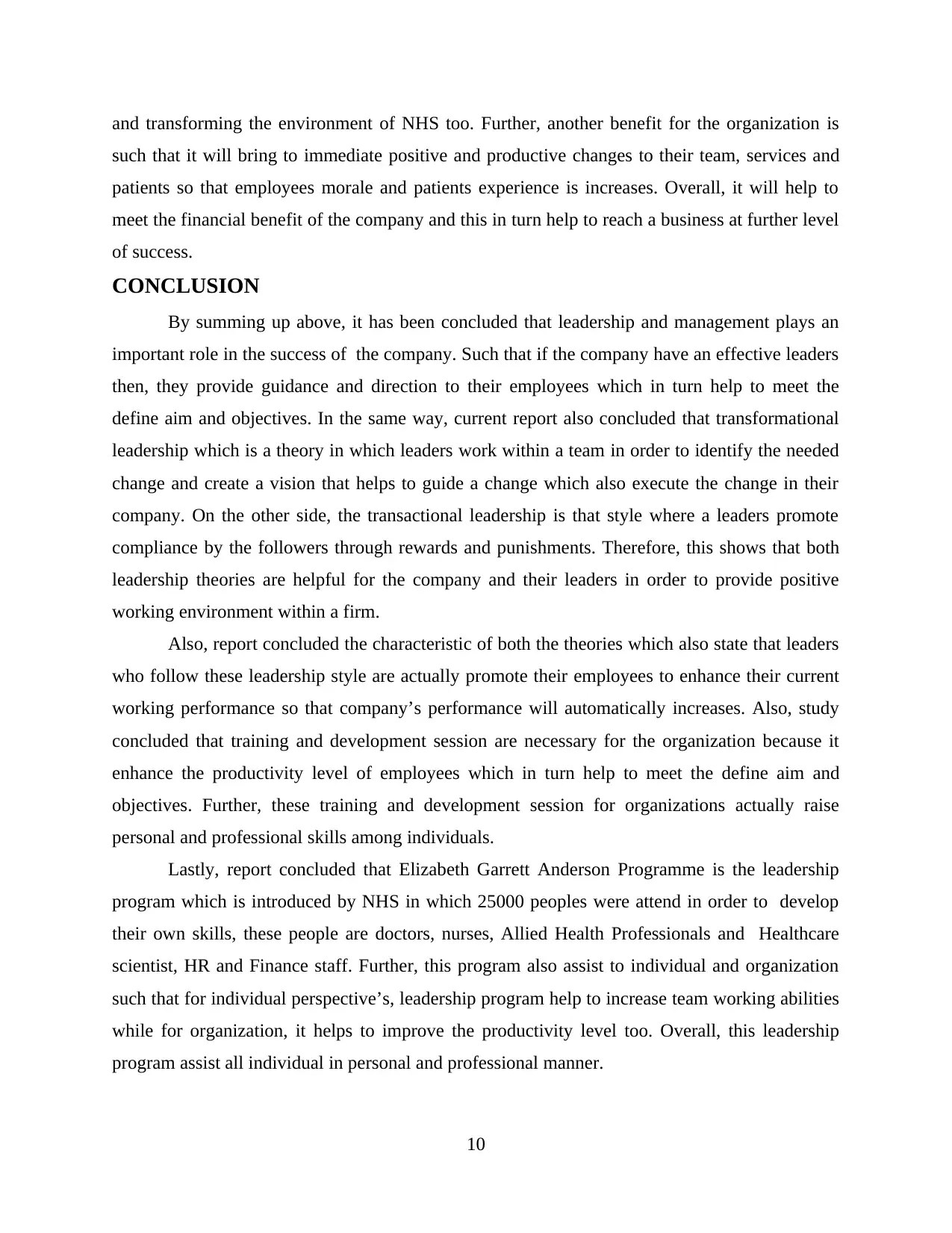
and transforming the environment of NHS too. Further, another benefit for the organization is
such that it will bring to immediate positive and productive changes to their team, services and
patients so that employees morale and patients experience is increases. Overall, it will help to
meet the financial benefit of the company and this in turn help to reach a business at further level
of success.
CONCLUSION
By summing up above, it has been concluded that leadership and management plays an
important role in the success of the company. Such that if the company have an effective leaders
then, they provide guidance and direction to their employees which in turn help to meet the
define aim and objectives. In the same way, current report also concluded that transformational
leadership which is a theory in which leaders work within a team in order to identify the needed
change and create a vision that helps to guide a change which also execute the change in their
company. On the other side, the transactional leadership is that style where a leaders promote
compliance by the followers through rewards and punishments. Therefore, this shows that both
leadership theories are helpful for the company and their leaders in order to provide positive
working environment within a firm.
Also, report concluded the characteristic of both the theories which also state that leaders
who follow these leadership style are actually promote their employees to enhance their current
working performance so that company’s performance will automatically increases. Also, study
concluded that training and development session are necessary for the organization because it
enhance the productivity level of employees which in turn help to meet the define aim and
objectives. Further, these training and development session for organizations actually raise
personal and professional skills among individuals.
Lastly, report concluded that Elizabeth Garrett Anderson Programme is the leadership
program which is introduced by NHS in which 25000 peoples were attend in order to develop
their own skills, these people are doctors, nurses, Allied Health Professionals and Healthcare
scientist, HR and Finance staff. Further, this program also assist to individual and organization
such that for individual perspective’s, leadership program help to increase team working abilities
while for organization, it helps to improve the productivity level too. Overall, this leadership
program assist all individual in personal and professional manner.
10
such that it will bring to immediate positive and productive changes to their team, services and
patients so that employees morale and patients experience is increases. Overall, it will help to
meet the financial benefit of the company and this in turn help to reach a business at further level
of success.
CONCLUSION
By summing up above, it has been concluded that leadership and management plays an
important role in the success of the company. Such that if the company have an effective leaders
then, they provide guidance and direction to their employees which in turn help to meet the
define aim and objectives. In the same way, current report also concluded that transformational
leadership which is a theory in which leaders work within a team in order to identify the needed
change and create a vision that helps to guide a change which also execute the change in their
company. On the other side, the transactional leadership is that style where a leaders promote
compliance by the followers through rewards and punishments. Therefore, this shows that both
leadership theories are helpful for the company and their leaders in order to provide positive
working environment within a firm.
Also, report concluded the characteristic of both the theories which also state that leaders
who follow these leadership style are actually promote their employees to enhance their current
working performance so that company’s performance will automatically increases. Also, study
concluded that training and development session are necessary for the organization because it
enhance the productivity level of employees which in turn help to meet the define aim and
objectives. Further, these training and development session for organizations actually raise
personal and professional skills among individuals.
Lastly, report concluded that Elizabeth Garrett Anderson Programme is the leadership
program which is introduced by NHS in which 25000 peoples were attend in order to develop
their own skills, these people are doctors, nurses, Allied Health Professionals and Healthcare
scientist, HR and Finance staff. Further, this program also assist to individual and organization
such that for individual perspective’s, leadership program help to increase team working abilities
while for organization, it helps to improve the productivity level too. Overall, this leadership
program assist all individual in personal and professional manner.
10
⊘ This is a preview!⊘
Do you want full access?
Subscribe today to unlock all pages.

Trusted by 1+ million students worldwide
1 out of 13
Related Documents
Your All-in-One AI-Powered Toolkit for Academic Success.
+13062052269
info@desklib.com
Available 24*7 on WhatsApp / Email
![[object Object]](/_next/static/media/star-bottom.7253800d.svg)
Unlock your academic potential
Copyright © 2020–2025 A2Z Services. All Rights Reserved. Developed and managed by ZUCOL.





